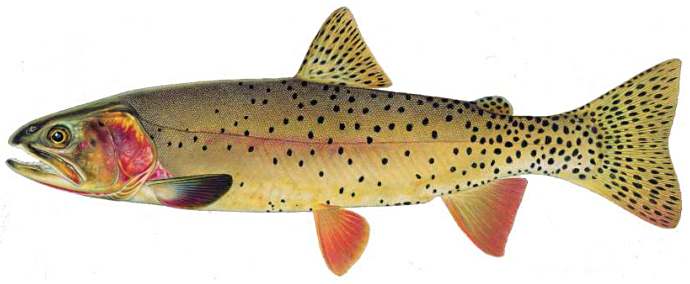NOT FOR HEADHUNTERS
Avoided By Braggarts
browliners don't even pause
your 2-wt. is too heavy !
your 2-wt. is too heavy !
(click on all images for high resolution views)
-------
.-------
 . It's not that we're secretive. It's not that we're selfish. It's not that we enjoy wildflowers, vast meadows,
. It's not that we're secretive. It's not that we're selfish. It's not that we enjoy wildflowers, vast meadows,  or wildlife to the exclusion of fishing. It's just that some places are so near and dear that they must be discovered to be appreciated.
or wildlife to the exclusion of fishing. It's just that some places are so near and dear that they must be discovered to be appreciated... There are a pair of streams, (trickles really,) about an hour or so from home that we visit a couple of times a year.
.. The are in the high country. They are spring fed. They parallel each other and, at one point, are less than 200 yards apart, and oh so different - one from the other.
-------
.. One of them is in the open for most of it's length, (not quite 2 miles.) It runs in the sun with only an occasional tree or bush on it's banks. .. Tall grass is the cover for shade. The banks are hardly undercut at all, and the shade is as important as a bowling ball sized boulder.
.. Tall grass is the cover for shade. The banks are hardly undercut at all, and the shade is as important as a bowling ball sized boulder... The other is shrouded in mystery. Thick brush overhangs the banks. Trees and their roots contort the stream into surprising convolutions as it wends it's way through an incised bed.
.. Deep, (up to two feet,) holes are always productive - if you can get to them. Ants and other bugs rain on us as we sneak through the growth. The fish are there, and hungry, and willing.
.. Neither is a fertile stream. Neither is full of bugs. Neither is inviting to the fisher folk of today. They are intimate, quiet, clear, cold, and pristine. The fish are uneducated, diminutive, and spooky as can be.
.. The feather merchants don't know their names. The guides never heard of them. Some neighbors think they are devoid of fish. Fishers drive past them and never even know they are there.
 .. There is wildlife everywhere: not the moose or elk or bear, or deer, (though they are here,) but ducklings, meadowlarks, ground squirrels, shrews, voles, flies, moths, ants, beetles, and such.
.. There is wildlife everywhere: not the moose or elk or bear, or deer, (though they are here,) but ducklings, meadowlarks, ground squirrels, shrews, voles, flies, moths, ants, beetles, and such... The birds have the usual high altitude habit of fluttering from bush to bush and hide to hide.
.. It's comical and occasionally surprising, (like a covey of huns bursting through your legs as you scan the horizon.)
-------
 .. We stalk the stream banks with a hand line, (5 feet of 5x tied to a golf tee - the fly is a bit of thread wrapped around a size 20 or 22 hook.) On the open creek, we crawl on our belly in the wet ooze of a perched water table. If nothing else it keeps us cool.
.. We stalk the stream banks with a hand line, (5 feet of 5x tied to a golf tee - the fly is a bit of thread wrapped around a size 20 or 22 hook.) On the open creek, we crawl on our belly in the wet ooze of a perched water table. If nothing else it keeps us cool... We turn over the cobbles at the edge of the water. Granite and quartzite, are predominant here; not the volcanic's of Yellowstone.
.. These mountains were here long before Yellowstone. They were here before the enormous eruptions of the super-volcano. The fish have endured glaciation, vulcanism, earthquakes, fire, drought, and other forces of nature: tough little scamps they are.
.. The food is sparse and very small. We recognize some of the fodder; most we don't. The green ones are easy. The stillborn neotenous forms are difficult!
.. We sometimes are so good at this creeping and crawling that we can tickle a fish in the belly. Most of the time a squadron of small fish zings ahead of the small silt plume that we cause. They are fast little devils: dark, glinting shadows in the water so clear it seems to disappear.
 .. We fish for them downstream with a calculated drift. Little swirls, eddies, cobble pillows and other currents must be taken into account.
.. We fish for them downstream with a calculated drift. Little swirls, eddies, cobble pillows and other currents must be taken into account... We place the fly in the water by hand. It takes some stealth and time. A long drift is three feet. We scare a lot of fish. There are a lot to scare. Monsters run to 6 or 7 inches. They leap and splash and we net them and turn them loose.
 .. There have been occasions when we just look & watch. Little fish, with colors and patterns to cause a bit of wonder. They are so bright out of the water. They disappear in the water. It's tough to see these little jewels. It's really a shame to catch them. We limit ourselves to two per creek per visit.
.. There have been occasions when we just look & watch. Little fish, with colors and patterns to cause a bit of wonder. They are so bright out of the water. They disappear in the water. It's tough to see these little jewels. It's really a shame to catch them. We limit ourselves to two per creek per visit... These are wild, indigenous trout. Westslope Cutthroat of the purest sort. A handful of biologists know that they exist. Some of the neighbors have visited them. No one goes to these creeks to fish, (save a couple of us crazies.)
.. It's as much about the place as the fish. Untrampled meadows, wildflowers, green's that defy description, and solitude are the attractions. There is a road nearby. It even has a forest service number.
.. We don't know if what we do is fly fishing. There's no vest, no fly rod, no fly reel,
 no waders, no fly boxes, no forceps, no accouterments from major catalog companies, and certainly no question of keeping the fish.
no waders, no fly boxes, no forceps, no accouterments from major catalog companies, and certainly no question of keeping the fish... There is no false casting. Neither is there a chance to mend the fly line. Hell, there is no fly line. We use a large net designed for home aquariums - does this qualify?
.. What ever it is we are doing it gets us out of a crowded tourist town. It lets us breath air thin, cold, and pure. It gives us the opportunity to visit with descendants of ten thousand or more generations of successful adaptation to a very harsh, pristine and beautiful part of the world. That's plenty good enough.
-------






.jpg)




